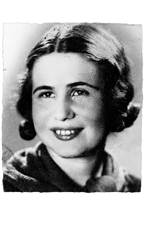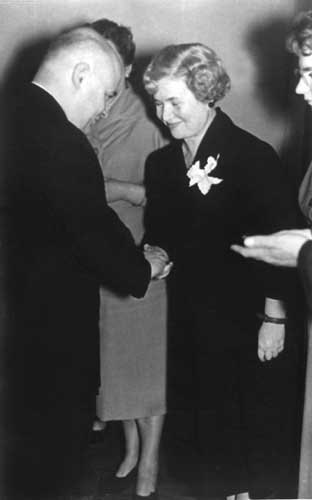
Irena Sendler: WWII Rescuer and Hero
by Peter K. Gessner
|
|
In October 1942, when in German-occupied Poland the Council for Aid to Jews - codename "Zegota" - was organized by the Polish Underground, Sendler was one of its first recruits. Thirty-two years old, she was at the time a Senior Administrator in the Warsaw Welfare Department. She had already been very involved in helping Jews before the Germans set up the Jewish Ghetto. She became the director of the Children’s Section of Zegota using the codename: Jolanta.
Sendler had already been helping Jews well before becoming the founding of Zegota. Her Welfare Department operated canteens for orphans, poor people and the destitute in every district of the city. Jews, whose bank accounts, real estate and property had been quickly confiscated by the Germans, found themselves among the ranks of the poor, yet by German edict were denied all forms of assistance. Sendler, having recruited at least one co-worker, or more correctly, co-conspirator from each of the ten centers of the Welfare Department, strove to find ways to circumvent the German edicts. Jewish families were registered under fictitious Christian names, were registered for short periods a tenants and to prevent inspections, their families were reported as being afflicted with such highly infectious diseases as typhus and tuberculosis. When the Ghetto was sealed, however, 90% of the 3000 Jews that were being helped through her efforts, ended up behind its walls.
|
|
For Sendler, a young mother herself, persuading parents to part with their children was in itself a horrendous task. Finding families on the Christian - so called Aryan side - willing to shelter the children, and thereby willing to risk being executed if the Germans ever found out, was also not easy. As a rule, the children were first placed in a temporary shelter, then to a foster home after they had somewhat recovered from their period of destitution. There was also a need to wait for them to receive from the Polish Underground false identity papers that were good enough to pass German muster. Each child had to be provided with a factitious birth and baptismal certificate and a family history of parents, siblings, aunts and uncles, etc. which the children, if old enough, had to commit to memory. Sendler carefully noted, in coded form, the children’s original names and their new identities and buried the information in glass jars in a garden so that at some point in the future they could be returned to their parents, or at least know who they had been. In all Sendler, her jars contained the names of 2,500 children.
On October 20, 1943 Sendler was arrested by the Gestapo. Although subjected to beatings and torture during which both of her feet and legs were broken, but not her spirit: she revealed nothing. Never again would she be able to walk without crutches. Sentenced to death, she was rescued by Zegota which, fearful that she would break down and reveal the location of the children, managed to bribe a guard to check off her name on a list of those already executed. As a result, she was listed on public bulletin boards as among those on whom a sentence of death had been carried out.
Rescued, she had to assume a completely new identity and liver an entirely new life. She could not visit her dying mother, nor attend her funeral. But she did again become deeply involved in the work of Zegota and after the war was able to give the children’s who’s who identify information to the Central Committee of Polish Jews.
In the post-war period she again immersed herself in the area of Social Welfare, working in the Ministry of Health. Having been in the Polish Underground was not looked upon with favor by Poland’s communist masters. Though she was never arrested by the Communist authorities, she was threatened that her children was not be allowed to have access to higher education.
In 1965 she accorded the title of Righteous Among the Nations by the Yad Vashem organization in Jerusalem and in 1991 she was made an honorary citizen of Israel. Interviewed in 1995 on camera in a 40-minute French documentary by Polish-born writer and film-maker Marek Halter, Sendler, her squinty, blue eyes awash with tears, recounted how she smuggled Jewish children out of the Warsaw Ghetto in an ambulance. In the front seat, a dog barked loudly to drown out the cries of her small passengers. Still visited by some of Jews she saved, ``I could have done more,'' she said. ``This regret will follow me to my death.''
Now 91 years old and confined to a wheelchair she continues to live in Warsaw where in May, 2001 she was visited by a group of four high school students from a rural school in Uniontown, Kansas. The students, accompanied by their parents and history teacher, came to meet the person whose life story inspired then to create a prize-winning dramatic presentation "Life in a Jar." The presentation, seen in many venues in the United States and popularized by National Public Radio, C-SPAN and CBS has brought Sendlers story of great courage and dedication to a wider public.
On October 23, 2003 Irena Sendler was honored by a $20,000 Jan Karski Freedom Award for Valor and Compassion by Freedom House and The American Center of Polish Culture.
| Info-Poland a clearinghouse of information about Poland, Polish Universities, Polish Studies, etc. |

